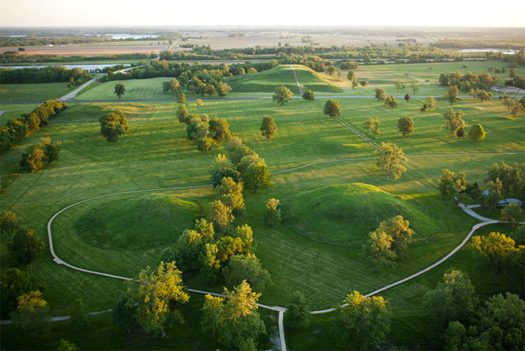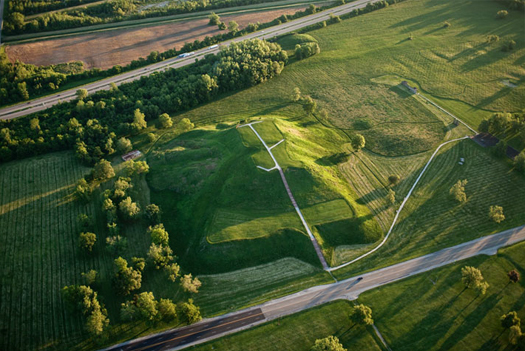

[Cahokia mounds, photographed by Ira Block for National Geographic; the mound immediately above is "Monk's Mound", the largest (ten stories tall) of the Cahokia mounds.]
Around a month ago, FASLANYC ran an excellent post that described the Mississippian mound culture as a potential source of inspiration for a reconsidered Louisiana delta urbanism. In the post, FASLANYC describes the mounds themselves as a “multifunctional networked infrastructure”:
“The Mississippians were a “mound-building people”, a fragmented and fractious empire loosely associated and bound together through cultural practices, trade, and their shared environmental situation. The capital was Cahokia — at the time the largest North American city north of Mexico — and is a prime example of this cultural practice of mound-building. While the archeological mounds are laden with cultural significance [and this is what anthropologists tend to focus on it seems], these constructions can also be seen as a dispersed, cellular adaptation to the dynamic hydrological condition of the Mississippi Valley.
We find it interesting that even in this year’s record high flood, the indian mounds near Kincaid, Illinois stayed dry. Trawling through the wildlife and game message boards, we came across this great thread where hunters are discussing the animals that have taken refuge on the local indian mounds, as well as the roofs of homes. This activity is not limited just to animals. In a 1927 issue of Science in an article titled “Indian Mounds as Flood Refuges” we read:
The thousands of terror-stricken people who have taken to Indian mounds to escape the flooding Mississippi waters are showing scientists how the Indians probably used these earthworks which they built in pre-Columbian days.
And later…
“The buildings [on top of the mounds] were probably temples, altars and the habitats of chieftains,” said [anthropologist] Dr. Kidder. “In time of flood a mound could accommodate the entire tribe, most of the members of which probably lived in the inundated area.”
Pyramidal in structure, but with a flat top to permit erection of buildings, the mounds are about 150 feet in diameter and some fifty feet high. They are largely confined to the flood area of the Mississippi. This practice of mound-building varied across the empire, from a few small hills near Kincaid to the imperial complex of Cahokia to the shell middens of the Louisiana Delta. It happened at a regional landscape scale — across the entire Midwest and much of the Southeast. And the mounds were not just burial sites, giant cosmological clocks, or the temple of the high priest; they were a multifunctional networked infrastructure — the construction of the territory as an articulated surface for resisting periodic inundation.”
There are many questions that could be raised about whether the specific content of this infrastructural precedent is worth adapting, as FASLANYC suggests it could be in the specific case of New Orleans; but what I am more interested in is the general strategy of appropriating infrastructural tactics from other, earlier (and/or distant) American societies. (Within the context of thinking about flooding, I’m interested in this because it is clear that, while America’s current riverine and littoral infrastructures do much of the work that they were intended to, they have also created unanticipated problems, face what appear to be a growing regime of unprecedented challenges, and will not last forever, particularly at today’s absymal maintenance levels.)
In particular, the practice of mound-building demonstrates very clearly the reason that infrastructurists interested in developing a specifically American infrastructural urbanism would do well to look back to the way previous American societies urbanized — it’s not just that they occupied the same ground that we do (the kind of historical precedent where a designer says “there was once a theater here, and so this restaurant will be theater-themed!”), but that there are specific tactics for responding to the unique conditions of the American landscape that are worth recalling. Not “that’s how it was”, but “that’s how it worked”. They dealt with the same set and magnitude of landscape processes that we do (processes which are significantly different from the Western European models we tend to rely on)1, and it seems quite possible that, in millennia of pre-colonial urbanization, American societies might have discovered a few useful tactics.




















